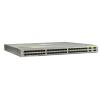-
Kč

Cisco Nexus N3K-C3064PQ-10GX to zarządzalny switch (przełącznik) warstwy Layer 2/3. Wyposażony jest w 48 slotów SFP+ (przepustowość 100 Mb/s / 1 Gb/s / 10 Gb/s) oraz 4 sloty QSFP+ (przepustowość 10 / 40 Gb/s). Urządzenie posiada obudowę przystosowaną do montażu w szafie Rack 19", wysokość wynosi 1U. Ma 2 zasilacze, które pracują redundantnie - w przypadku awarii jednego drugi odpowiada za zasilanie. Dostępne opcje zasilania: 2x zasilacz AC (100 - 240 V AC), 2x zasilacz DC (40 - 72 V DC) lub zasilacz AC + DC.
Maksymalna przepustowość przełączania wynosi 1,28 Tb/s, a prędkość przekazywania pakietów 950 Mp/s. Switch wspiera wiele funkcji routingu w warstwie Layer 3, w tym także BGP oraz OSPF. Oprócz tego posiada wszystkie niezbędne funkcje Layer 2 i doskonale nadaje się do obsługi multicastów.
W zestawie znajdują się wzmocnione uchwyty Rack.
Najważniejsze cechy:
- 48 slotów SFP+ (maks. 10 Gb/s);
- 4 sloty QSFP+ (maks. 40 Gb/s);
- przepustowość przełączania: 1,28 Tb/s;
- prędkość przekazywania pakietów: 950 Mp/s;
- zarządzanie Layer 2 i 3;
- BGP i OSPF;
- zasilanie AC.
Specyfikacja:
| Nexus N3K-3064PQ-10GX | |
| Ogólne właściwości fizyczne |
Obudowa Rack 19" 1U 48 slotów SFP wspierających przepustowość 1/10 Gb/s 4 sloty QSFP+ wspierające przepustowość 10/40 Gb/s 2 redundantne źródła zasilania Wentylator |
| Wydajnośc |
Przepustowość przełączania: 1,28 Tb/s Prędkość przekazywania pakietów: 950 Mp/s Line-rate traffic na wszystkich portach (Layer 2 i 3) Maks. MTU - 9216 (jumbo frames) |
| Właściwości sprzętowe | |
|---|---|
| Adresy MAC | 128000 |
| Numery VLAN | 4096 |
| Instancje Spanning-tree |
RSTP: 512 MST: 64 |
| ACL entries |
2000 ingress 1000 egress |
| Tablica routingu |
16000 prefixów / 16000 host entries 8000 multicast routes (dane uzależnione od wersji softu) |
| Ilość EtherChannels | 64 (z vPC) |
| Ilość portów na EtherChannel | 32 |
| Bufor | 9 MB (dzielony) |
| Pamięć boot flash | 2 GB |
| Zasilanie | |
| Ilość zasilaczy | 2 |
| Rodzaje zasilaczy | AC |
| Średni pobór |
143 W z Twinax przy 100% obciążenia 177 W z SR optics przy 100% obciążenia |
| Maksymalny pobór mocy | 199 W |
| Zasilacz AC |
100 - 240 V AC 50 -60 Hz Sprawność 89 - 91% przy 220 V |
| Średnie wydzielanie ciepła |
488 BTU/hr (Twinax / 100% obciążenia) 605 BTU/hr (SR optics / 100% obciążenia) |
| Maksymalne wydzielane ciepło | 683 BTU/hr |
| Cechy pozostałe i środowiskowe | |
| Głośność |
Wentylator na 40%: 59,7 dBA Wentylator na 60%: 66,4 dBA Wentylator na 100%: 71 dBA |
| Wymiary |
Wysokość: 4,4 cm Szerokość: 43,9 cm Długość: 50,5 cm |
| Waga | 9,3 kg |
| Dopuszczalna temperatura pracy | Od 0 do 40 st. C |
| Dopuszczalna temperatura przechowywania | Od -40 do 70 st. C |
| Dopuszczalna wilgotność powietrza |
10%-85% niekondensująca Przy maks. wilgotności switch może pracować góra 5 dni |
| Dopuszczalna wilgotność powietrza podczas przechowywania | 5%-95% niekondensująca |
| Właściwości oprogramowania | |
| Layer 2 | Layer 2 switch ports and VLAN trunks IEEE 802.1Q VLAN encapsulation Support for up to 4096 VLANs Rapid Per-VLAN Spanning Tree Plus (PVRST+) (IEEE 802.1w compatible) Multiple Spanning Tree Protocol (MSTP) (IEEE 802.1s): 64 instances Spanning Tree PortFast Spanning Tree Root Guard Spanning Tree Bridge Assurance Cisco EtherChannel technology (up to 32 ports per EtherChannel) Link Aggregation Control Protocol (LACP): IEEE 802.3ad Advanced PortChannel hashing based on Layer 2, 3, and 4 information vPC Jumbo frames on all ports (up to 9216 bytes) Storm control (unicast, multicast, and broadcast) Private VLANs |
| Layer 3 | Layer 3 interfaces: Routed ports on interfaces, switch virtual interfaces (SVIs), PortChannels, and subinterfaces (total: 1024) 64-way ECMP 2000 ingress and 1000 egress ACL entries IPv6 routing: Static, OSPFv3, and BGPv6 Routing protocols: Static, RIPv2, EIGRP, OSPF, and BGP Bidirectional Flow Detection (BFD) for BGP, OSPF and ipv4 Static routes HSRP and VRRP ACL: Routed ACL with Layer 3 and 4 options to match ingress and egress ACLs VRF: VRF-lite (IP VPN), VRF-aware unicast (BGP, OSPF, and RIP), and VRF‑aware multicast Unicast Reverse-Path Forwarding (uRPF) with ACL; strict and loose modes Jumbo frame support (up to 9216 bytes) Generic Routing Encapsulation (GRE) tunneling |
| Multicasty |
Multicast: PIMv2, PIM-SM, and SSM Bootstrap router (BSR), Auto-RP, and Static RP Multicast Source Discovery Protocol (MSDP) and Anycast RP Internet Group Management Protocol (IGMP) Versions 2 and 3 |
| Quality of Service (QoS) |
Layer 2 IEEE 802.1p (class of service [CoS]) 8 hardware queues per port Per-port QoS configuration CoS trust Port-based CoS assignment Modular QoS CLI (MQC) compliance ACL-based QoS classification (Layers 2, 3, and 4) MQC CoS marking Differentiated services code point (DSCP) marking Weighted Random Early Detection (WRED) CoS-based egress queuing Egress strict-priority queuing Egress port-based scheduling: Weighted Round-Robin (WRR) Explicit Congestion Notification (ECN) Configurable ECN (Marking) per port |
| Zabezpieczenia | Ingress ACLs (standard and extended) on Ethernet Standard and extended Layer 3 to 4 ACLs include IPv4, Internet Control Message Protocol (ICMP), TCP, and User Datagram Protocol (UDP) VLAN-based ACLs (VACLs) Port-based ACLs (PACLs) Named ACLs ACLs on virtual terminals (vtys) DHCP snooping with Option 82 Port number in DHCP Option 82 DHCP relay Dynamic Address Resolution Protocol (ARP) inspection Configurable CoPP |
| Cisco Nexus Data Broker | Topology support for tap andSPAN aggregation Support for QinQ to tag input source tap and SPAN ports Traffic load balancing to multiple monitoring tools Traffic filtering based on Layer 1 through Layer 4 header information Traffic replication and forwarding to multiple monitoring tools Robust RBAC Northbound Representational State Transfer (REST) API for all programmability support |
| Zarządzanie | POAP Python scripting Cisco EEM Switch management using 10/100/1000-Mbps management or console ports CLI-based console to provide detailed out-of-band management In-band switch management Locator and beacon LEDs Configuration rollback SSHv2 Secure Copy (SCP) server Telnet AAA AAA with RBAC RADIUS TACACS+ Syslog Syslog generation on system resources (for example, FIB tables) Embedded packet analyzer SNMP v1, v2, and v3 Enhanced SNMP MIB support XML (NETCONF) support Remote monitoring (RMON) Advanced Encryption Standard (AES) for management traffic Unified username and passwords across CLI and SNMP Microsoft Challenge Handshake Authentication Protocol (MS-CHAP) Digital certificates for management between switch and RADIUS server Cisco Discovery Protocol Versions 1 and 2 RBAC Switched Port Analyzer (SPAN) on physical layer, PortChannel, and VLAN Tunable Buffer Allocation for SPAN Encapsulated Remote SPAN (ERSPAN) Ingress and egress packet counters per interface PTP (IEEE 1588) boundary clock Network Time Protocol (NTP) Cisco OHMS Comprehensive bootup diagnostic tests Cisco Call Home Cisco DCNM Advanced buffer utilization monitoring sFlow |
| MIB |
Generic MIBs ● SNMPv2-SMI ● CISCO-VLAN-MEMBERSHIP-MIB ● ENTITY-MIB Monitoring MIBs ● NOTIFICATION-LOG-MIB ● CISCO-AAA-SERVER-MIB ● CISCO-LICENSE-MGR-MIB ● UDP-MIB |
| Standardy | IEEE 802.1D: Spanning Tree Protocol IEEE802.1p: CoS Prioritization IEEE 802.1Q: VLAN Tagging IEEE 802.1s: Multiple VLAN Instances of Spanning Tree Protocol IEEE 802.1w: Rapid Reconfiguration of Spanning Tree Protocol IEEE 802.3z: Gigabit Ethernet IEEE 802.3ad: Link Aggregation Control Protocol (LACP) IEEE 802.3ae: 10 Gigabit Ethernet (Cisco Nexus 3064-X) IEEE 802.3ba: 40 Gigabit Ethernet IEEE 802.3an:10GBASE-T (Cisco Nexus 3064-T and 3064-32T IEEE 802.1ab: LLDP IEEE 1588-2008: Precision Time Protocol (Boundary Clock) |
| RFC |
BGP ● RFC 1997: BGP Communities Attribute ● RFC 2328: OSPF Version 2 ● RFC 1724: RIPv2 MIB Extension ● RFC 2236: Internet Group Management Protocol, version 2 |
| Bezpieczeństwo | UL 60950-1 Second Edition CAN/CSA-C22.2 No. 60950-1 Second Edition EN 60950-1 Second Edition IEC 60950-1 Second Edition AS/NZS 60950-1 GB4943 |
| EMC |
47CFR Part 15 (CFR 47) Class A EN55024 |






 Polski
Polski English
English Italiano
Italiano Español
Español Čeština
Čeština Српски
Српски Deutsch
Deutsch Ελληνικά
Ελληνικά Slovenský
Slovenský





